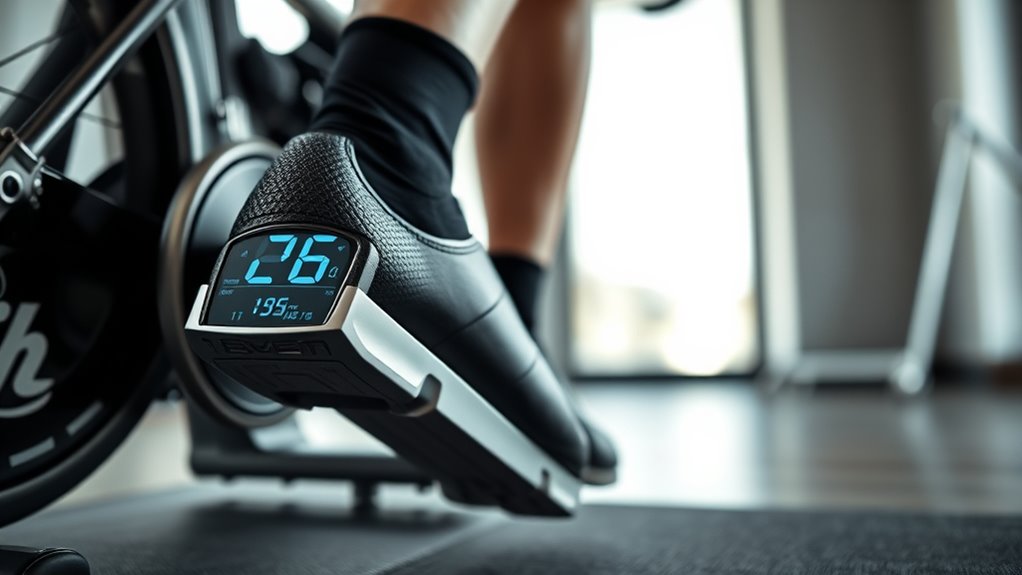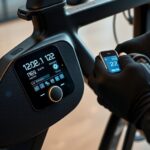To measure your trainer’s power accuracy, verify it’s calibrated correctly by performing zero offsets and spin-down tests. Compare its readings with trusted external power meters like Quarq or Power2Max to spot discrepancies, usually within 1-3%. Proper setup, stable environmental conditions, and consistent calibration are key. Watch for unusual spikes or drift, and regularly verify your equipment’s performance. Keep exploring to learn how to troubleshoot and fine-tune for more reliable data.
Key Takeaways
- Use external power meters (e.g., Quarq, Power2Max) to cross-verify trainer readings within 1-3% accuracy range.
- Perform calibration procedures such as zero offset and spin-down tests before each ride for baseline accuracy.
- Ensure proper installation, tightness, and environmental stability to prevent measurement errors and sensor noise.
- Compare power data across multiple devices and analyze peaks, lags, and consistency to identify discrepancies.
- Regularly update firmware and check connections to maintain measurement reliability and detect hardware issues.
Understanding Power Measurement Fundamentals
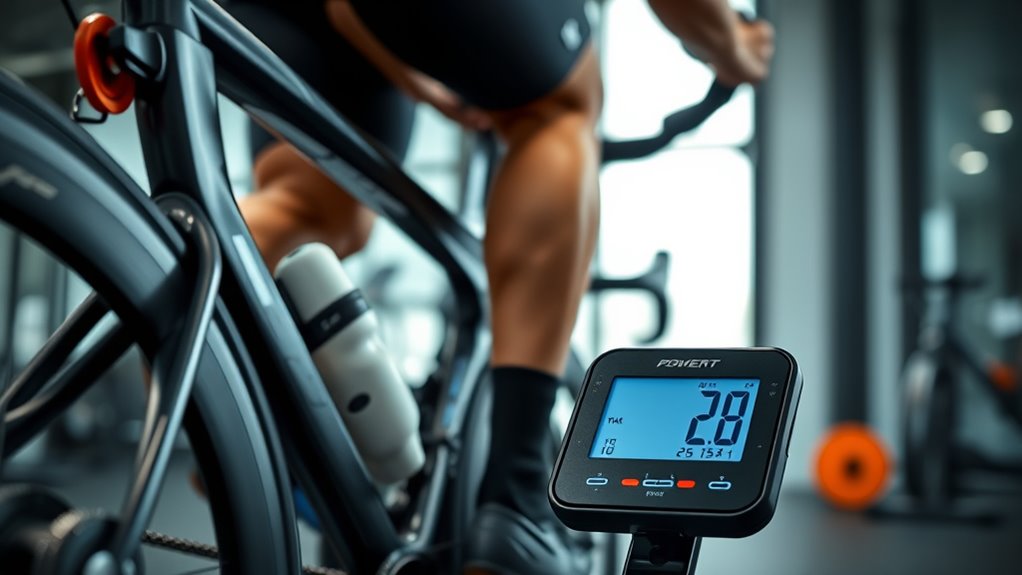
To accurately measure power on trainers, it’s essential to understand how they generate those readings. Power measurement relies on sensors—either strain gauges or electromagnetic types—that calculate force and torque to determine wattage. The accuracy of these readings depends on proper calibration and setup, along with maintaining consistent resistance settings. High-quality trainers claim ±1-2% precision, but drivetrain losses, such as chain and cassette inefficiencies, can cause discrepancies. Different resistance types—wind, magnetic, fluid, and electric—have unique measurement characteristics and reliability levels. External factors like temperature, tire pressure, and contact force also influence the consistency and accuracy of power readings during indoor training. Recognizing these fundamentals helps you better interpret your trainer’s data and optimize your training. Additionally, sensor calibration is crucial for maintaining measurement accuracy over time, especially considering potential drivetrain losses that can affect wattage readings. Furthermore, understanding resistance mechanisms can help you select the most accurate trainer for your needs, and being aware of environmental factors can aid in achieving consistent measurements. Moreover, advances in digital sensor technology are continuously improving the precision and reliability of power measurements.
Ensuring Proper Installation and Calibration
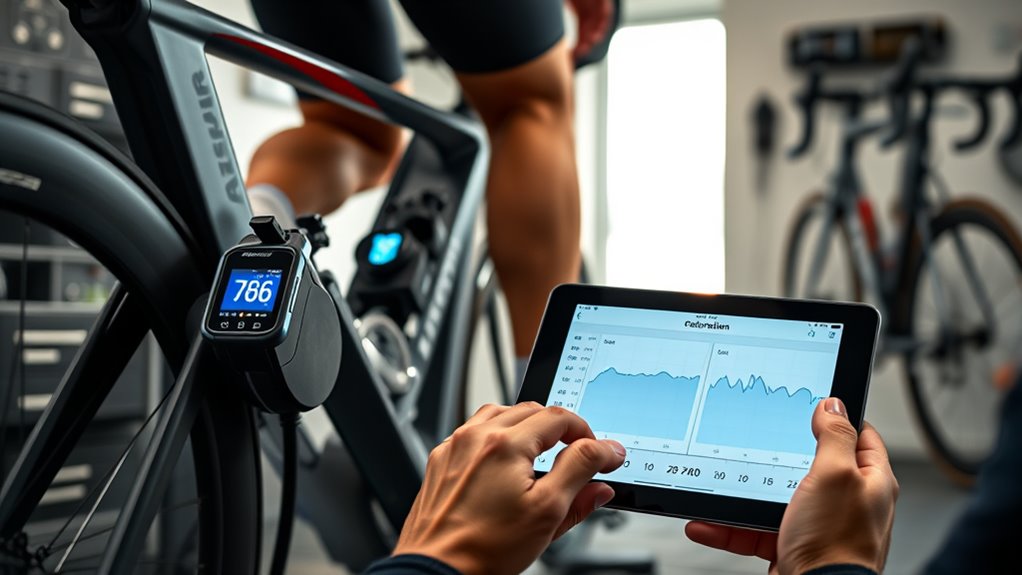
Ensuring proper installation and calibration is essential for accurate power readings on your trainer. Start by confirming all bolts are tightened to manufacturer-specified torque settings, especially for crank or pedal-based power meters, to prevent inaccuracies. Conduct a zero offset or calibration before each ride to account for temperature fluctuations and setup differences, maintaining measurement consistency. Perform spin-down or roll-down tests to calibrate resistance levels accurately, using dedicated apps or protocols if needed. Keep the resistance unit—magnetic, fluid, or electric—functioning correctly and check environmental conditions, like temperature and humidity, which can affect readings. Clear dirt, debris, and ensure good contact quality between components to reduce errors. Minimizing signal interference from other electronics also helps ensure your power data remains precise and reliable. Additionally, understanding the tuning options available for different Honda models can help optimize your vehicle’s performance and ensure accurate engine output measurements. Regularly inspecting your setup and understanding calibration procedures can further improve your measurement accuracy and consistency. Incorporating proper maintenance routines can also extend the lifespan of your equipment and sustain measurement accuracy over time.
Comparing Trainer Power Readings With External Meters
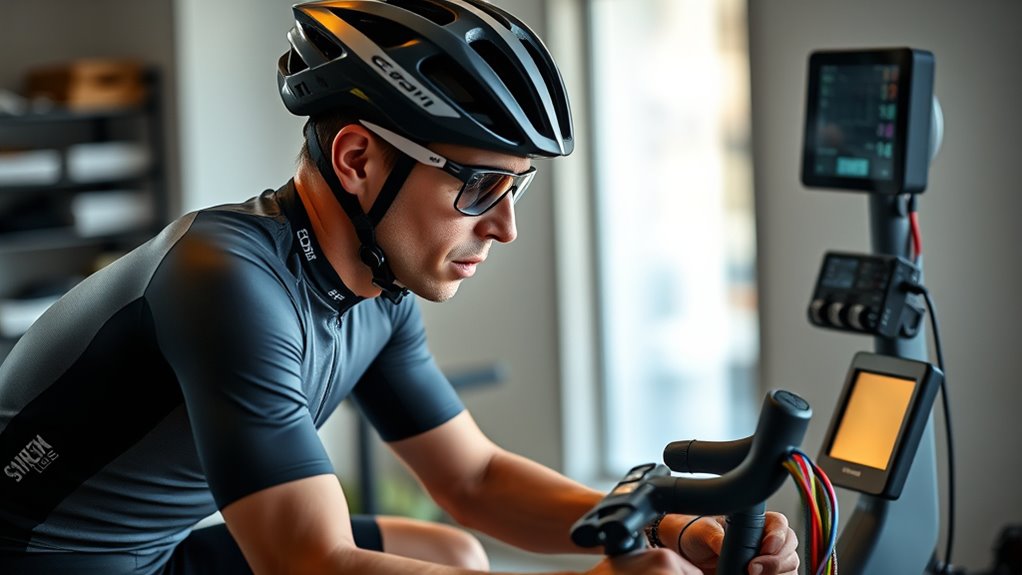
Comparing your trainer’s power readings with external meters like Quarq or Power2Max is crucial for verifying accuracy, but discrepancies of about 1-3% are common. These differences can result from calibration issues, setup variations, or inherent system biases. Using external power meters provides a reference point for accuracy testing your trainer’s power measurement. High-quality direct drive trainers typically show closer agreement, within 1-2%, whereas wheel-on trainers may exhibit more power discrepancies due to contact and tire pressure factors. Cross-referencing multiple external meters helps identify systematic bias, especially during high-intensity efforts or rapid power changes. Regular calibration and controlled efforts are essential to ensure your trainer’s power readings align with external power meters, giving you confidence in your training data. Consistent testing procedures can further enhance measurement reliability and help detect subtle inaccuracies over time, especially considering the regional differences in available data and calibration standards. Additionally, understanding the inherent system biases of different trainers can aid in interpreting your power data more accurately. Incorporating standardized testing protocols can also minimize variability and improve the comparability of results across different devices.
Conducting Controlled Testing for Accuracy Evaluation

Conducting controlled testing involves performing multiple rides at steady FTP intensities and high-intensity sprints in erg mode to compare power readings across your trainer and external meters. This approach facilitates accurate power meter testing and accuracy evaluation. During these sessions, focus on controlled ride analysis by collecting consistent data, avoiding pauses, and ensuring proper data synchronization. Use heart rate-based alignment methods, like GPLama’s, to accurately compare datasets. Pay close attention to drift and lag by analyzing high-power peaks rather than just average power, which helps identify discrepancies. Repeating tests with different devices and setups enhances measurement consistency. Additionally, understanding how to Get a Divorce can influence the context of legal considerations and documentation involved in formal assessments. Incorporating knowledge of juice cleanses and their effects can also help inform proper hydration and nutrition strategies during testing, ensuring optimal performance and data accuracy. This method allows you to conduct thorough power data comparison, revealing potential inaccuracies and building confidence in your trainer’s power output measurement. For example, monitoring power accuracy over multiple sessions can reveal inconsistencies that may need calibration or troubleshooting. Understanding how to evaluate trainer calibration and perform necessary adjustments ensures your data remains reliable during training and testing.
Recognizing and Troubleshooting Common Issues
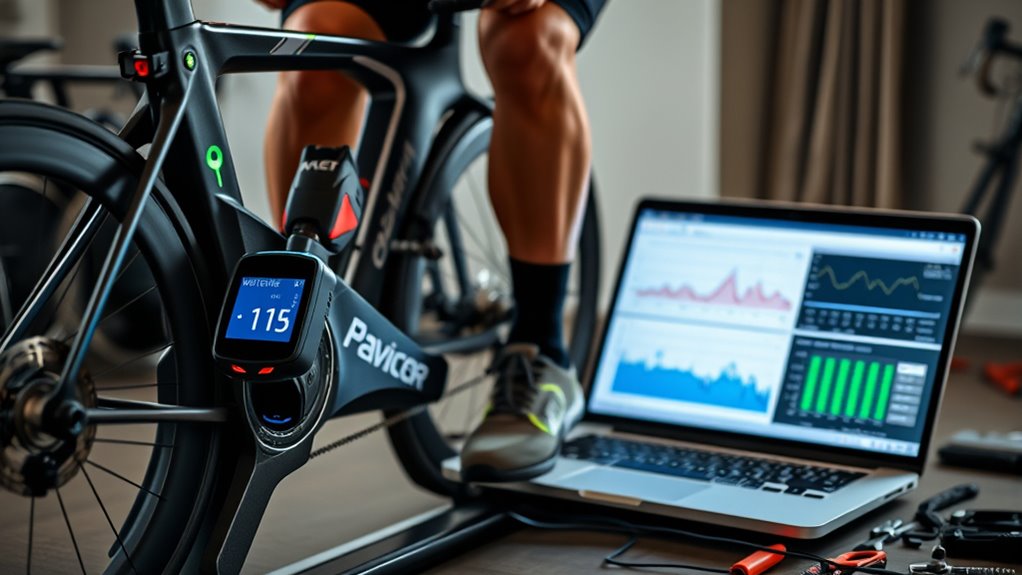
If your power readings suddenly spike above 1,000W without changing effort or cadence, it’s likely a hardware glitch or battery issue. Sudden jumps in cadence over 200 rpm can also cause inaccurate data due to sensor or calibration problems. Regularly checking for these issues and recalibrating guarantees your trainer’s measurements stay accurate. Additionally, ensuring your device uses the correct sensor calibration techniques can help prevent these discrepancies and ensure consistent data. Proper power meter maintenance routines can further enhance measurement reliability. Also, keeping an eye on filtering and data smoothing can improve the accuracy of your readings during intense sessions.
Detecting Power Spikes
Power spikes on trainers can be misleading indicators of effort, often caused by filtering errors, loose connections, or sensor noise rather than actual increases in wattage. These power spikes, such as readings reaching 22,000W or jumping from 1037W to 1516W, typically result from connection issues or firmware glitches within the device. Sensor noise, dropouts, or interference may produce irregular high wattage readings that don’t match your effort or heart rate. Analyzing data helps identify erroneous readings that don’t align with your workout intensity. Regularly updating firmware, ensuring proper equipment calibration, and checking connection stability can reduce power spikes. Recognizing these common signs allows you to troubleshoot effectively and maintain accurate power meter readings, improving your overall data analysis and training consistency.
Calibrating for Consistency
Calibrating your trainer regularly is essential to maintain accurate power readings, especially as temperature and setup conditions change during each ride. Proper calibration guarantees consistency by resetting baseline measurements through zero offsets and spin-down tests. Use manufacturer-recommended procedures to verify accuracy, and monitor calibration values over time—significant shifts may signal hardware issues or the need for recalibration. Remember, calibration doesn’t fix high-wattage spikes or device lag; it only resets the baseline. Troubleshoot inaccuracies by checking installation, updating firmware, and maintaining stable environmental factors like temperature and contact pressure.
| Calibration Step | Purpose |
|---|---|
| Zero offsets | Correct baseline drift |
| Spin-down tests | Verify dynamic accuracy |
| Monitor calibration | Detect hardware issues or environmental changes |
Analyzing Data for Consistency and Precision
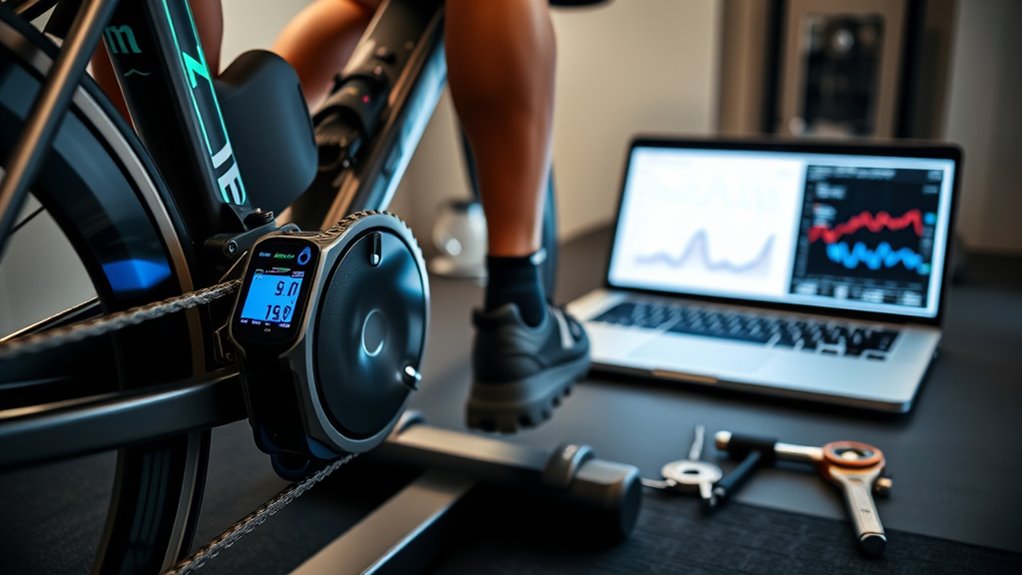
To guarantee your trainer provides reliable data, it’s essential to analyze the consistency and precision of its power readings. Start with data analysis, comparing power readings across multiple devices during the same workout to identify potential inconsistencies. Focus on measurement accuracy by examining power peaks and their lag relative to set resistance, revealing how accurately the device captures rapid changes. Drift monitoring during steady efforts helps assess device reliability over time. Implement test protocols, such as repeated FTP intervals, to evaluate measurement precision objectively. Cross-referencing power data with heart rate, perceived exertion, and external power sources enhances accuracy validation. Performing a performance comparison allows you to spot deviations and ensure your trainer maintains consistent, precise power readings, reinforcing confidence in your training data.
Maintaining Your Equipment for Reliable Measurements
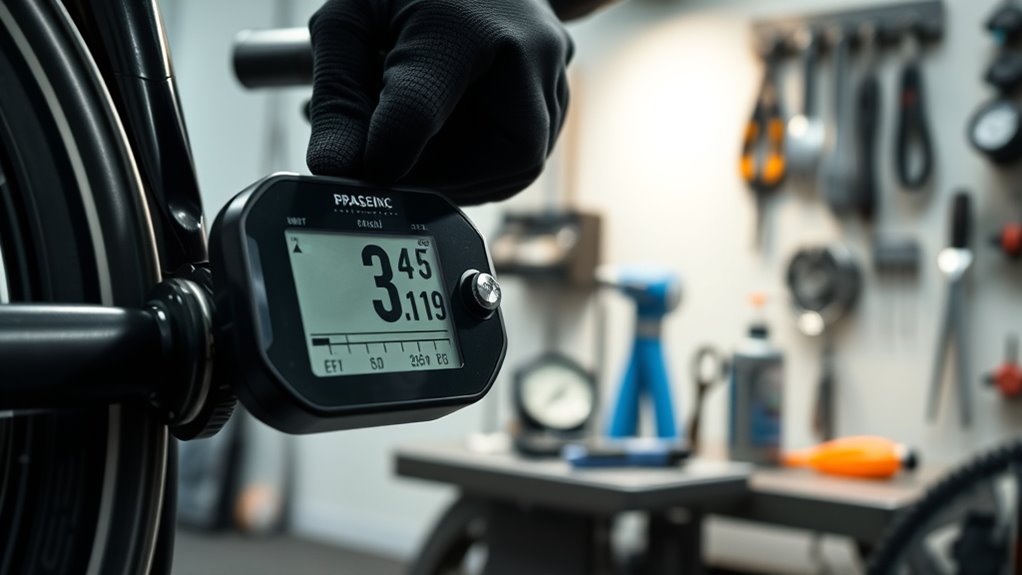
Maintaining your equipment is essential for ensuring consistent and accurate measurement of your power output. Proper maintenance prevents measurement errors caused by loose connections, temperature fluctuations, or outdated firmware. To keep your trainer reliable:
- Regularly calibrate your trainer and power meter following manufacturer instructions to maintain accuracy.
- Keep resistance units clean and monitor temperature changes that could affect calibration and measurement consistency.
- Check and tighten all bolts, especially on crank arms, pedals, and components involved in power measurement, to avoid loose contact force and setup issues.
Frequently Asked Questions
What Is the Most Accurate Measure of Power Output When Riding a Bike?
You want the most accurate measure of your power output while riding. To get this, use a high-quality external power meter like Quarq or Favero Assioma, as they’re considered the gold standard for precision. Make sure to calibrate regularly and keep your setup stable. These devices, combined with consistent calibration routines, give you reliable, precise data to track your performance accurately.
Does Kickr Measure Power?
You wonder if the KICKR measures power? Yes, it does. The Wahoo KICKR uses an integrated power meter to track your output, relying on flywheel speed and resistance. You can trust its readings, as they’re calibrated internally and designed for accuracy within about 1%. To keep measurements precise, make sure to calibrate regularly, update firmware, and set up your trainer correctly, ensuring consistent performance every ride.
What Is Power Accuracy?
Power accuracy tells you how close your trainer or power meter’s readings are to your actual power output. You want readings within a small margin, like ±1-2%, but factors like calibration, setup, and environment can cause deviations. To get reliable data, regularly calibrate your device, set it up correctly, and understand its limitations. This way, you can trust your power measurements for training and performance tracking.
Do You Need a Power Meter With a Smart Trainer?
You might wonder if you need a separate power meter with your smart trainer. If your trainer’s built-in power measurement is accurate and certified, you probably don’t need extra gear. However, if you want the highest precision for racing or detailed training, adding an external power meter can give you more reliable and consistent data. Consider your goals and trainer’s calibration to decide what’s best for you.
Conclusion
Just like a master chef trusts their knife’s sharpness, you can trust your trainer’s power accuracy by staying vigilant. Regular calibration and careful testing guarantee your workouts hit their mark, much like Sherlock Holmes solving a mystery. Keep your equipment maintained, analyze your data, and troubleshoot issues promptly. With these steps, you’ll navigate your training with confidence, turning every ride into a win—because, after all, precision is the secret ingredient to your success.
